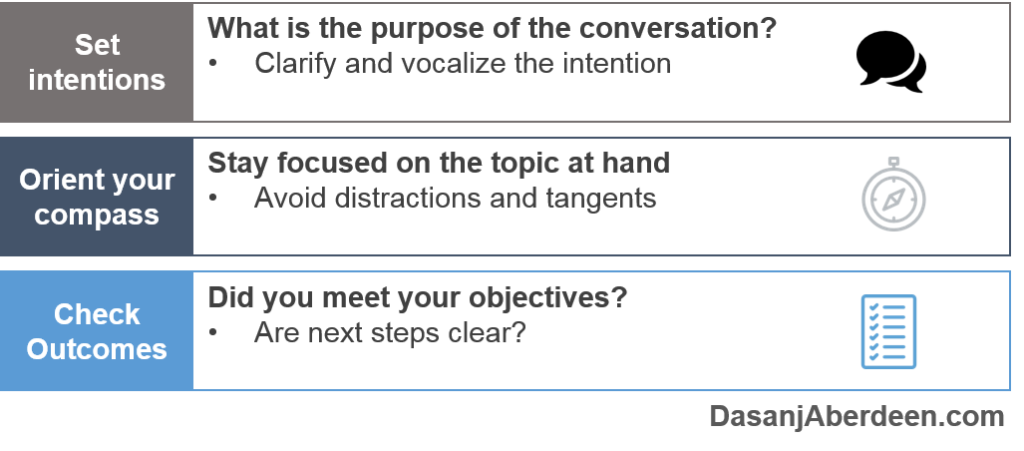Recent events in my personal life highlighted how important it is to know and communicate intentions clearly. Initially, I couldn’t think of how to address this in a personal situation. But I realized there are other aspects in life where intentions are present, clearly communicated and have a positive impact. Then I thought of ways how I could apply the structure from these situations.
We’ve all had good meetings and bad meetings. The bad ones leave us wondering what we met about, why the meeting was held in the first place and uncertain about next steps. On the other hand, a good meeting has clearly outlined objectives, the right audience in attendance, remains on topic and has clear next steps and action items.
So why not leverage this approach for more effective communications with a family member, partner or friend? Here’s an actionable approach:
Set intentions upfront. What is the purpose of the conversation? What do you want to achieve? Do you want to share your point of view? Do you want to better understand the other person’s point of view? Do you want a mutual agreement to resolve your differing points of view? First, you need to know what you want. Next, it is important to vocalize it so expectations are set and all parties know what they’re working toward. You don’t always need a destination, sometimes it is about the journey, but you’re more likely to get there if you know where you’re heading.
Use intentions as a compass. Once conversation is underway, it is easy to drift off, get distracted, pivot or end up on a tangent. Comments and points will trigger additional thoughts and the different parties will want to mention them, even if they’re not directly related to the topic at hand. How you handle this? It is best to use the intentions set upfront for guidance – as a compass if you will – to keep the conversation focused. This will guide the comments, actions and behavior of all parties. Even if your points are countered, you’ll have more confidence and clarity in your responses and comments when you remember the agreed upon objective.
You don’t always need a destination, sometimes it is about the journey, but you’re more likely to get there if you know where you’re heading.
Check your outcomes. Having set and communicated your intentions upfront, you can easily check if this approach works. At the end of the conversation, simply ask all parties: Did we accomplish what we outlined at the beginning of the conversation? Do we have a clear path forward? Successfully applying the above approach makes it easier to answer these questions. There should be no ambiguity and no party should question the purpose of the conversation and what it accomplished. And everyone should be clear on what happens next.
This is an example of how principles and approaches from certain areas of life can apply and be relevant to other, unrelated areas. I couldn’t think of a model to use in my personal situation, but in looking at a business scenario, I found a tried-and-true approach used for effective meetings. I’d love to hear how this works for you in a meeting, conversation or another communication scenario!
Dasanj Aberdeen is an entrepreneurial spirit who embodies the combination of left-brain logic and right-brain creativity. She is a consultant and proponent of multidisciplinary education, approaches and pursuits. She writes about their benefits in modern times and integrating multiple interests into a sustainable and fulfilling lifestyle. She’s a graduate of The Wharton School of the University of Pennsylvania and Temple University with a concentration in Technology & Innovation Management, jointly delivered by the Fox School of Business and College of Engineering.



